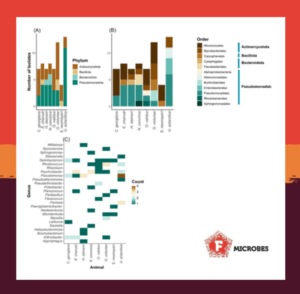The Antarctic environment harbours diverse and abundant microbial communities, with many of its endemic species occurring nowhere else in the world. Bacteria living in Antarctic marine creatures are of interest because they produce chemicals with various functions. The study “Psychrotrophic Antarctic marine bacteria as potential reservoirs for novel antimicrobial genes” in FEMS Microbes identified several new bacterial isolates and showed the antimicrobial capacity of two bacteria from an Antarctic Sea anemone, as explained by Kudzai Hwengwere. #FascinatingMicrobes
Antarctic bacteria as potential sources for antimicrobial chemicals
With the ever-increasing global antimicrobial resistance crisis, the search is on for novel antibiotics. Organisms living in extreme environments have evolved mechanisms to withstand and overcome a wide variety of environmental stressors. This includes heat, cold, desiccation, hypoxia, heavy metals, and more.
Extreme organisms have already provided us with enzymes and chemicals of practical applications. That’s why they have the potential to be valuable sources for further new biomolecules.
Antarctica, our planet’s coldest continent, is surrounded by a permanently cold ocean, where temperatures rarely rise above 0 °C. Despite the cold, these waters harbour a highly biodiverse ecosystem.
More than 17,000 marine invertebrate species are estimated to live in the Southern Ocean. So far, only a handful of them are characterised in detail at the physiological or ecological levels. Even less is known about the microbial communities associated with these invertebrates; microbes which may have evolved interesting compounds to enable them to thrive at 0 °C.
Hence, this study “Psychrotrophic Antarctic marine bacteria as potential reservoirs for novel antimicrobial genes” in FEMS Microbes aimed to extend our knowledge on bacteria associated with eight common Antarctic marine invertebrates.
Antarctic bacteria with antimicrobial activity and high stress tolerance
Bacteria were isolated from seven Antarctic marine invertebrates, including a sea anemone, a brittle star, three sea cucumbers, a limpet, starfish, and a sea urchin. After molecular identification, bacteria were grown at different temperatures and salt concentrations to optimise protein expression. They were then tested for antimicrobial activity against five human pathogens

Two bacterial strains from the Pseudomonas sp. and Psychrobacter sp. demonstrated antimicrobial activity against the three common pathogens: epidemic methicillin-resistant Staphylococcus aureus, Micrococcus luteus, and Candida albicans. Genome sequencing revealed that the newly isolated Psychrobacter strain could be a novel species. Its genome even contained several novel genes producing products with antimicrobial potential.
Interestingly, the bacteria produced the novel antimicrobial compound(s) at higher temperatures, though they did not do so reliably in liquid culture. However, genome analysis showed that both bacteria contain gene clusters slightly similar to the biosynthetic gene cluster of the antimicrobial compound fengycin.
More detailed analysis of the genome would help understand the chemicals these bacteria can produce. At the same time, trying different growth conditions may help their production in the lab setting.
Lastly, whilst attempting to trigger the bacteria into producing antibiotics, the study discovered that some of the Antarctic bacteria can grow at temperatures as high as 35 ˚ C. This was surprising, considering they live in a stable environment between -1 and +2 ˚ C.
This study provides a plethora of new avenues for investigation. Although Antarctic bacteria might be untapped reservoirs for new antibiotics, standard growth methods may not reveal their actual potential.
It might be possible that the bacteria produce potential antimicrobial compounds at temperatures or salt concentrations that were not tested in this study. Also freezing during the transport process might have affected produced compounds. So, while this study doesn’t answer all these questions, the search for new antibiotics from the Antarctic goes on.
- Read the article “Psychrotrophic Antarctic marine bacteria as potential reservoirs for novel antimicrobial genes” by Hwengwere et al. in FEMS Microbes (2025).

Kudzai Hwengwere is a final year PhD student at the British Antarctic Survey and the University of Plymouth.
Grant January is a Lecturer in Microbiology at the University of Plymouth, School of Biomedical Sciences.
Kerry Howell is a Professor of Deep-Sea Ecology at the School of Biological and Marine Sciences, University of Plymouth and Plymouth Marine Laboratory.
Professor Lloyd Peck, FRS is a Science Leader the British Antarctic Survey.
Mathew Upton is Professor of Medical Microbiology at the University of Plymouth, School of Biomedical Sciences.
Professor Melody Clark is a Project Leader at the British Antarctic Survey.
About this blog section
The section #FascinatingMicrobes for the #FEMSmicroBlog explains the science behind a paper and highlights the significance and broader context of a recent finding. One of the main goals is to share the fascinating spectrum of microbes across all fields of microbiology.
| Do you want to be a guest contributor? |
| The #FEMSmicroBlog welcomes external bloggers, writers and SciComm enthusiasts. Get in touch if you want to share your idea for a blog entry with us! |
